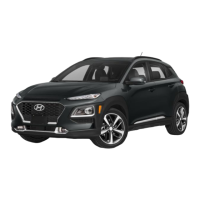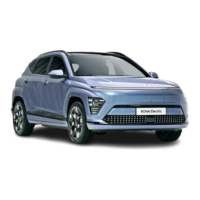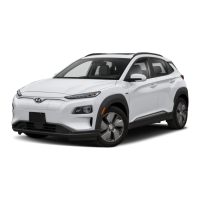
Do you have a question about the Hyundai Kona Electric 2018 and is the answer not in the manual?
| Brand | Hyundai |
|---|---|
| Model | Kona Electric 2018 |
| Category | Automobile |
| Language | English |
Details on how to operate the vehicle's features and functions.
Keeping the vehicle in good condition and performing regular checks.
Technical details and specifications of the vehicle.
Indicates a hazardous situation that will result in death or serious injury if not avoided.
Indicates a hazardous situation that could result in death or serious injury if not avoided.
Indicates a hazardous situation that could result in minor or moderate injury if not avoided.
Indicates a situation that could result in vehicle damage if not avoided.
Explains safety messages and symbols used in the manual and on vehicle labels.
Basic definition and operation of an electric vehicle.
Key features differentiating electric vehicles from traditional cars.
Details on the high voltage and auxiliary batteries powering the vehicle.
Information on battery status, range, and energy consumption.
Device converting AC power to DC to charge the high voltage battery.
Converts DC to AC for motor and AC to DC for battery charging.
Low Voltage DC-DC converter supplying power to vehicle systems.
Uses battery power to drive the vehicle.
Delivers motor's rotational force to tires.
Stores and supplies power necessary for the electric vehicle's operation.
How to find charging stations using the vehicle's navigation system.
Checking battery information and energy consumption data.
Setting charging schedules, departure times, and climate control.
Information on CO2 reduction and driving history for eco-friendly driving.
Charging the vehicle using AC chargers at home or public stations.
High-speed charging at public stations, with cautions on frequent use.
Charging using standard household electricity with a portable charger.
Step-by-step instructions for starting the vehicle.
Understanding the vehicle's remaining range.
Indicates when the vehicle is ready to be driven.
Alerts to potential problems in the electric vehicle control system.
Message when connecting charger without P-mode.
Critical steps to take in the event of a vehicle accident.
A visual guide to the vehicle's front exterior features.
Identification of key controls and features within the vehicle's cabin.
Layout and functions of the instrument cluster and dashboard controls.
Location of major components within the vehicle's motor compartment.
Essential safety advice for driving and passenger well-being.
Information on seat adjustments, features, and safety.
Proper use, precautions, and safety features of seat belts.
Guidelines for securely installing and using child restraint systems.
Details on the vehicle's airbag system, operation, and safety precautions.
Information on using the smart key for vehicle access and starting.
How to operate the vehicle's door locking and unlocking systems.
Details on steering wheel adjustments and controls.
Information on adjusting and operating the vehicle's mirrors.
Operation of the power windows and related features.
Instructions for operating the vehicle's sunroof and sunshade.
Overview of the instrument cluster display and controls.
Explanation of the various gauges and meters on the instrument panel.
Information on using the trip computer for driving data.
Operation and precautions for the Head-Up Display system.
Control and operation of the vehicle's exterior and interior lighting.
Operation of the windshield and rear window wipers and washers.
Information on driver assistance features like rear view monitor.
Operation of the automatic climate control system.
Essential pre-drive checks and safety preparations before operating the vehicle.
Explanation of the power button's positions and operation.
Explanation of how regenerative braking works and paddle shifter usage.
Overview of the vehicle's braking system, including power brakes and EPB.
Explanation of how the ABS system functions and its limitations.
Details on the ESC system's operation and how to disable it.
Functionality and precautions for the Forward Collision-Avoidance Assist system.
Explanation of the Blind-Spot and Rear Cross-Traffic Collision Warning systems.
LKA system operation and limitations.
How the Driver Attention Warning system monitors driver fatigue.
Functionality and limitations of the Intelligent Speed Limit Warning system.
How to set and operate the speed limit control system.
Instructions for using and operating the Cruise Control system.
Operation of the Smart Cruise Control system with stop and go functionality.
Advice for driving in challenging conditions like snow or mud.
Recommendations for safe driving during winter conditions.
Information regarding the vehicle's towing capabilities.
How to operate the hazard warning flashers for signaling emergencies.
Troubleshooting steps when the vehicle fails to start.
Detailed procedure and safety precautions for jump-starting the 12V battery.
Steps to take if the vehicle's engine begins to overheat.
Information about the TPMS, including checks and malfunctions.
Instructions for using the Tire Mobility Kit to temporarily fix a flat tire.
Guidelines and recommendations for towing the vehicle.
Overview of the types of maintenance services available and recommended.
A schedule of basic checks and inspections the owner can perform.
Details on recommended maintenance intervals based on usage conditions.
Information about the vehicle's cooling system and coolant checks.
Details on checking and maintaining the brake fluid level.
Information on inspecting and replacing the climate control air filter.
Guidance on inspecting and replacing windshield wiper blades.
Information about the 12-volt battery, including safety precautions.
Information on tire care, selection, and maintenance.
Overview of the vehicle's fuse system and replacement procedures.
Information on replacing various vehicle light bulbs.
General guidelines for maintaining the vehicle's appearance.
Vehicle dimensions including length, width, height, and wheelbase.
Technical specifications for the electric powertrain components.
Wattage specifications for all vehicle light bulbs.
Information on tire load index and speed rating.
Recommended types and quantities of lubricants and fluids for the vehicle.
Location and importance of the Vehicle Identification Number (VIN).












